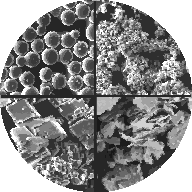Select from the available options below:
The 173 page book Fundamentals of Particle Technology is available free-to-download as separate chapters in pdf format.
It is an introductory text written for university students studying engineering, or science. Students should be familiar with the basic concepts of lamina and turbulent flow, and basic differential calculus.
At the end of each book chapter there are problems, that have been decomposed for the student, in to small steps. They are mainly in multiple choice format with, unusually, the commonly selected incorrect answer not present. By this means the student will know if he, or she, has obtained the correct answer. The Video files of worked solutions are complete worked solutions for the problems, using YouTube hosted mp4 files. Comments are enabled on YouTube to allow further Q&A to be contributed.
The multiple choice questions, at the end of each chapter, can be attempted interactively online using the Online interactive end of chapter problems. Most of the questions have hints to help in their solution and Javascript should be enabled for answer checking. No data is stored on the server, nor student's machine, the problems are provided solely for personal education purposes.
The Solutions to problems, downloads, misc. section includes downloadable Excel spreadsheets containing the solutions to the problems, as well as some additional videos illustrating the subjects covered in the book. There is also an online particle settling velocity calculator, valid for all reasonable Particle Reynolds Number as it uses the Heywood Table approach.
Designing, controlling, or simply understanding a process based on particle technology often starts with a conversation about the particle size and morphology of the particles within the process. There are numerous methods available for particle size analysis and the Expert System for particle sizing has been designed to rank a number of techniques in order of applicability, based on user supplied information about the particles and the intended process to be designed, controlled, or simply understood.
The About section provides some details about the motivation behind the web-site, history and contact details.

